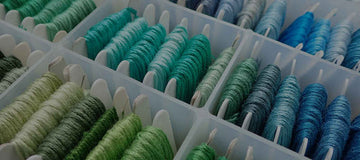Stitch Smarter, Not Harder: Top 5 Cross-Stitch Blunders and Their Fixes
Welcome to the intricate world of cross-stitch, where precision meets creativity! As stitchers, we all want to create pieces that truly shine. However, even the most experienced needleworkers can stumble upon a few common pitfalls.
In this blog post, I’ll walk you through the top 5 cross-stitch blunders and share practical tips on how to avoid them so you can stitch smarter, not harder. Whether you’re a seasoned pro or just starting your cross-stitch journey, these tips will help you create stunning, mistake-free pieces.
Don't miss #5 as I feel like it's the most important mistake to correct!
-
Incorrect Fabric Count
Choosing the right fabric count is like laying a strong foundation for your cross-stitch project. A mismatch between your fabric and the pattern can lead to disappointing results, such as your design being too large to frame or so small that details get lost. To avoid this, always start by double-checking the fabric count specified in your pattern. Use a ruler or fabric gauge to measure the threads per inch on your cloth, especially if you’re unsure of its count.
For beginners, Aida cloth is a great choice since its grid-like structure makes it easier to see and follow. Starting with the right fabric ensures your piece will turn out just as you envisioned!
Here’s how to avoid this:
- Double-check the fabric count recommended in your pattern.
- Use a ruler or gauge tool to confirm the fabric's threads per inch.
- If you’re new to cross-stitch, try starting with Aida cloth since it has a more visible count.
-
Knotted Threads
Knotted threads can disrupt your stitching flow and create a messy appearance. They often happen when threads twist or are too long, making your work harder to manage. To prevent knots, cut your thread into manageable lengths — about 18 inches (Or roughly the length of your wrist to your armpit) is ideal for most stitches. Letting your needle dangle periodically while stitching allows the thread to untwist naturally.
If you find knots persist, using a thread conditioner like beeswax or silicone-based products can help keep your threads smooth and tangle-free. With these habits, you’ll spend less time fixing knots and more time enjoying the process.
To prevent knots:
- Use shorter lengths of thread (around 18 inches works well).
- Let your needle and thread dangle from the fabric every so often to prevent twisting.
- Consider using a thread conditioner for extra smoothness.

A simple, common knot that can occur while cross-stitching. -
Inconsistent Tension
Tension is everything in cross-stitch; it’s what ensures your piece looks professional and even. Pulling your thread too tight can cause puckering, while loose threads can result in gaps. Using a hoop or frame to keep your fabric taut is one of the simplest ways to maintain consistent tension. Pay attention to how your stitches feel as you pull them through the fabric — aim for a balance where they lay flat without distorting the cloth. Lastly, keep all your stitches uniform by crossing them in the same direction.
Mastering tension takes practice but leads to beautiful, even results.
To get there:
- Avoid pulling the thread too tight or leaving it too loose.
- Use a hoop or frame to keep your fabric taut.
- Cross your stitches in the same direction consistently, so they look uniform.
-
Dirty Work
Cross-stitch is a hands-on craft, and keeping your project clean is essential for a professional finish. Oils, dirt, or accidental spills can tarnish your hard work. Make it a habit to wash your hands before each session to keep your project spotless. When you’re not stitching, cover your work with a clean cloth or paper towel to protect it from dust.
If you notice small marks or dirt, don’t panic — use gentle cleaning techniques like a light wash in cool water with mild detergent. A clean project is not just more enjoyable to work on; it also ensures your final piece
✨ shines ✨.Here are some tips to ensure a pristine result:
- Wash your hands before stitching to avoid transferring oils and dirt.
- Use a cover like a fabric or paper towel when you’re not actively stitching.
- If your piece does get a little dirty, follow proper cleaning methods to avoid any damage.
![An [unfortunate] stain on the edge of the fabric of a cross-stitch project](https://cdn.shopify.com/s/files/1/0732/3733/2277/files/241218-img-problem_dirt.jpg?v=1734553679)
An unfortunate stain on the edge of a finished cross-stitch. -
Cross-Stitch Direction
I feel like this is the most important mistake to correct!
This seemingly small detail can make a huge difference in the overall appearance of your cross-stitch. When all your top stitches face the same direction, your work looks polished, cohesive, and professional. Consistency is key, so establish a standard direction for your top stitches right from the start — for example, always stitching from bottom left to top right. Make it a habit to check your stitches as you go; catching inconsistencies early will save you time and frustration later.
Correcting this mistake elevates your project from good to great, creating a truly flawless finish.
Here’s how to stay consistent:
- Choose a standard direction for your top stitch (for example, bottom left to top right).
- Check each section as you go to make sure your stitches are aligned.
- If you find inconsistencies, fix them early before it affects larger sections.
Happy Stitching, Every Time
Cross-stitch is a blend of precision and creativity, and by steering clear of these common mistakes, you can focus on the joy of creating something uniquely yours. Mistakes are just part of the journey, so stitch with confidence and let your creativity shine!
At Two Little Kits, I love sharing tips to make your cross-stitching smoother and more enjoyable. Personally, as someone with adult-diagnosed ADHD, I understand the joy that comes from overcoming obstacles in crafting and life. Balancing a creative outlet with the responsibilities of daily life can be challenging, but with these simple tips, I hope you’ll feel confident in avoiding common cross-stitch mistakes and focusing on what really matters — the joy of creating something beautiful. Happy stitching! 🧵





